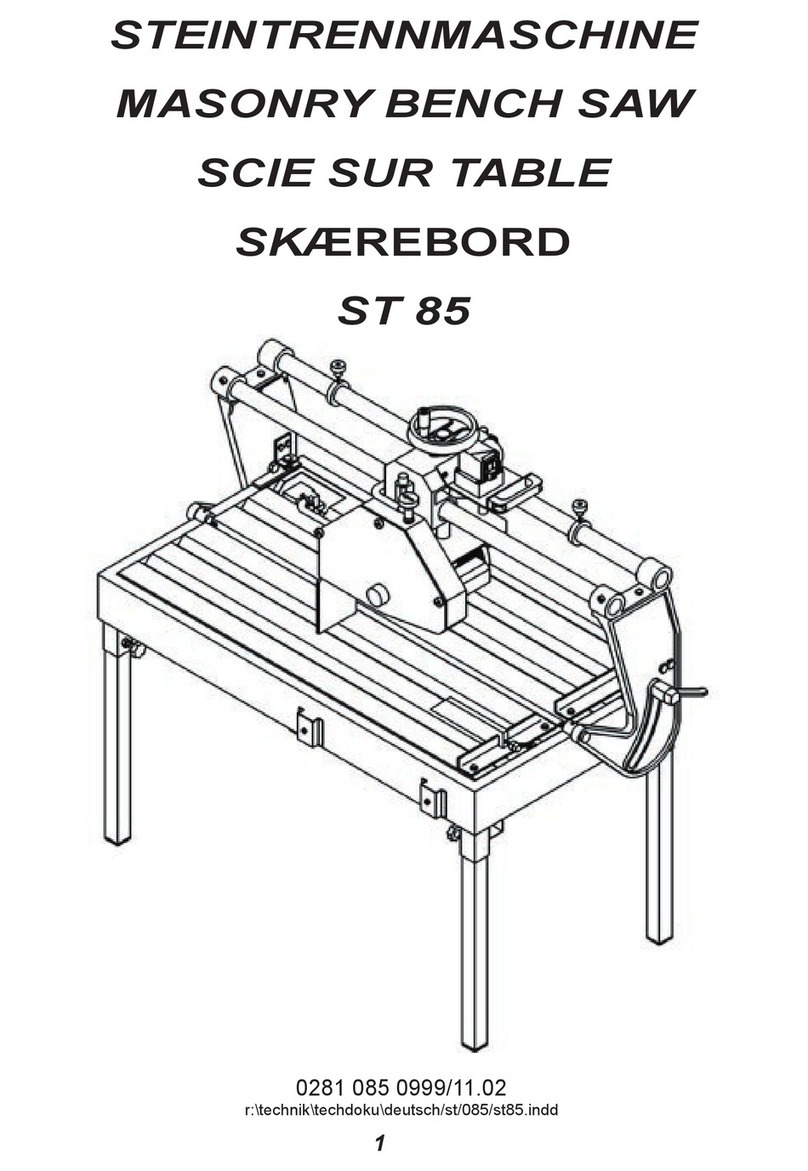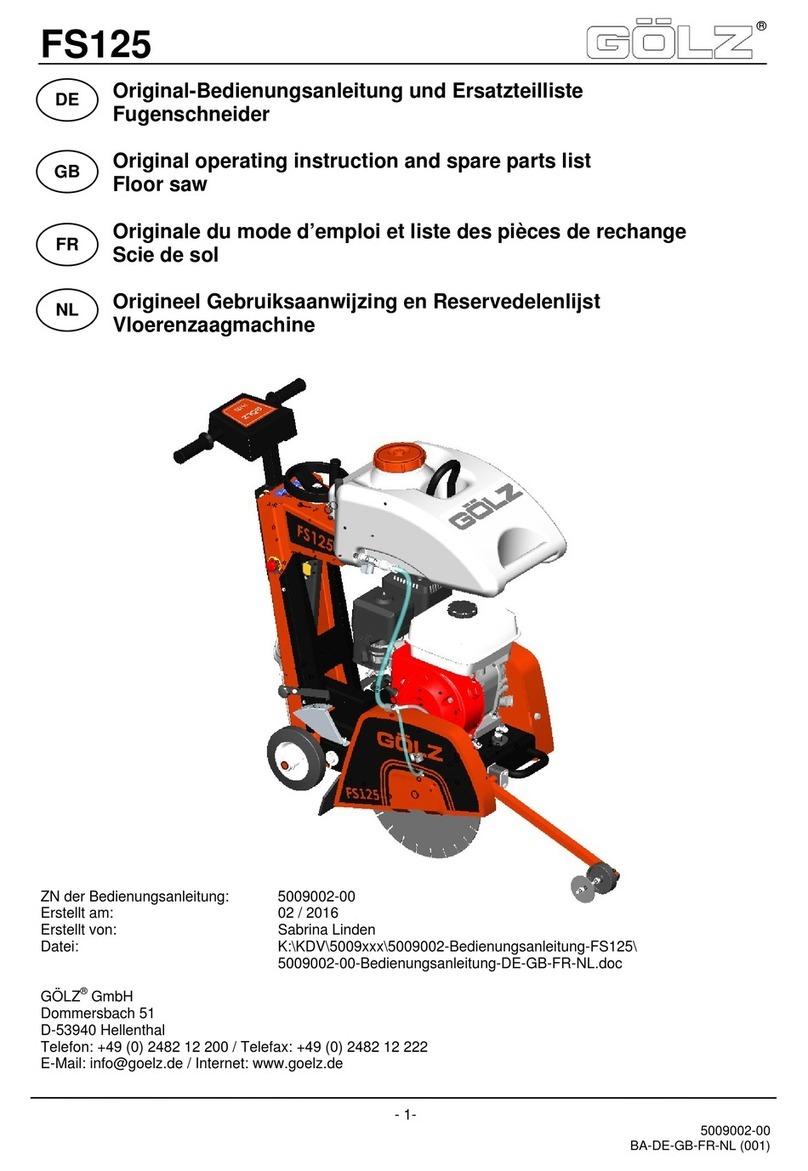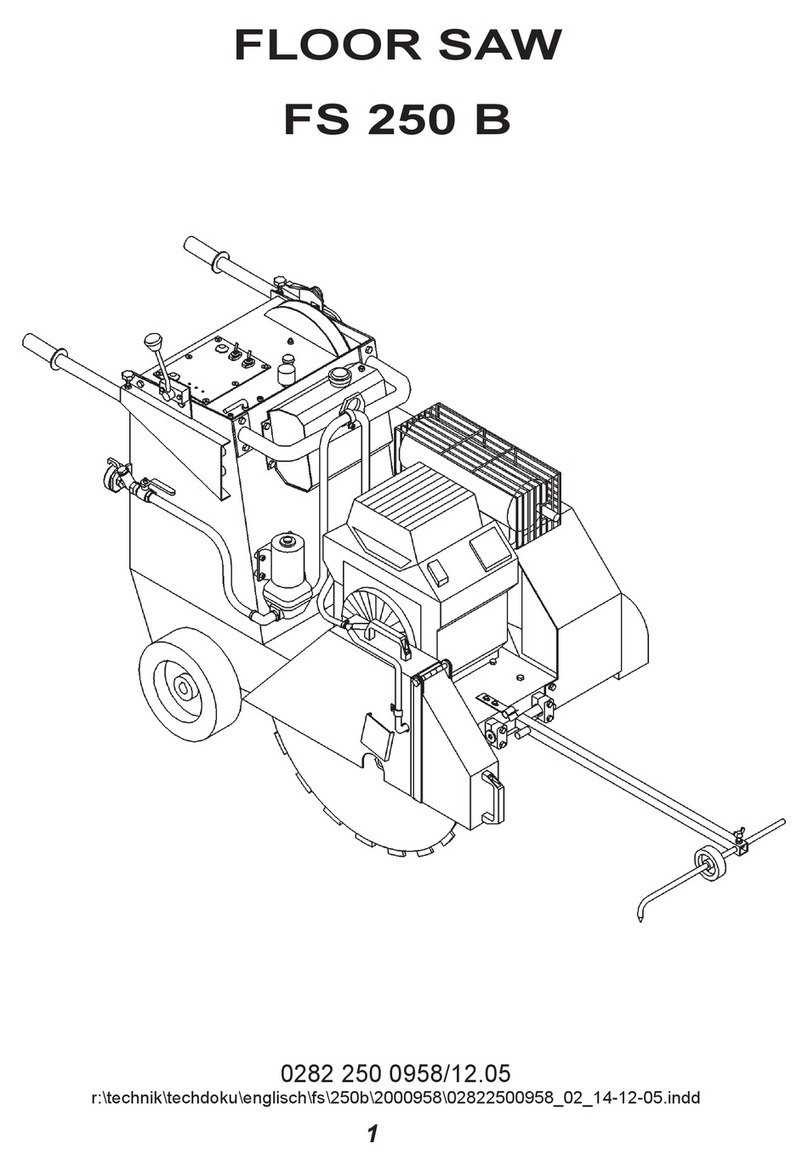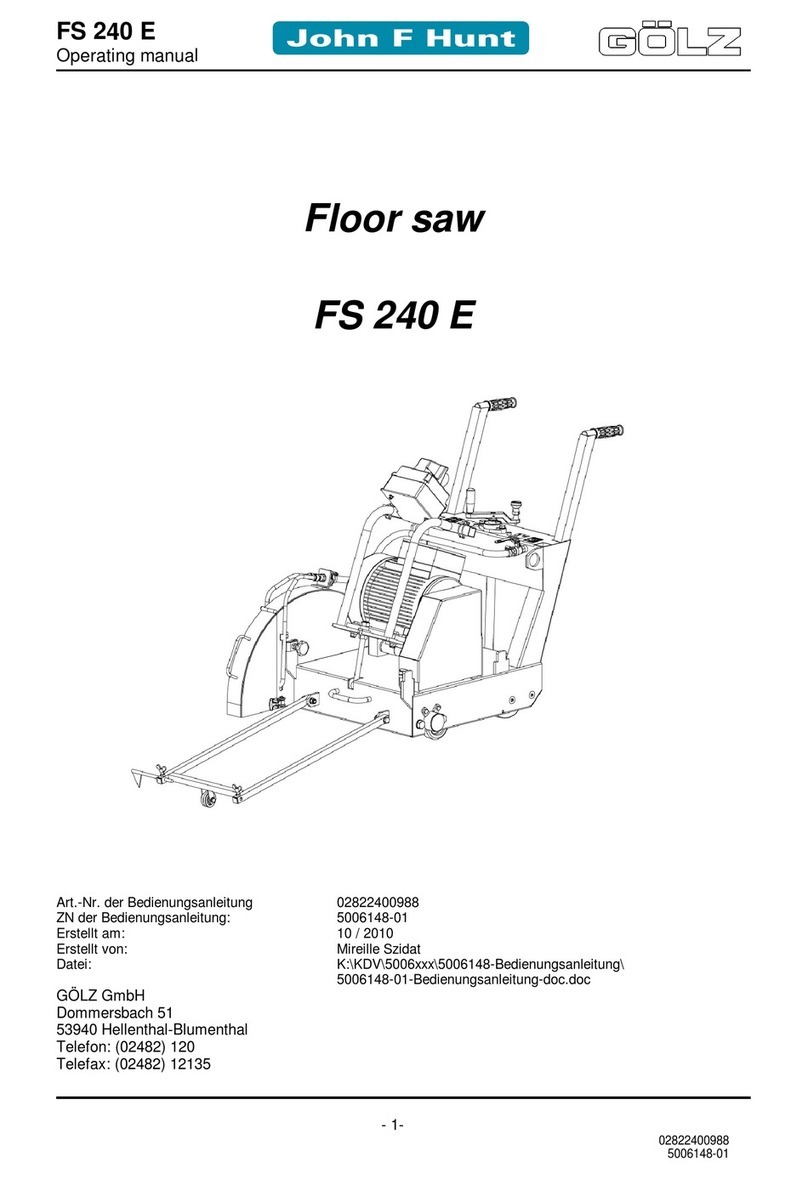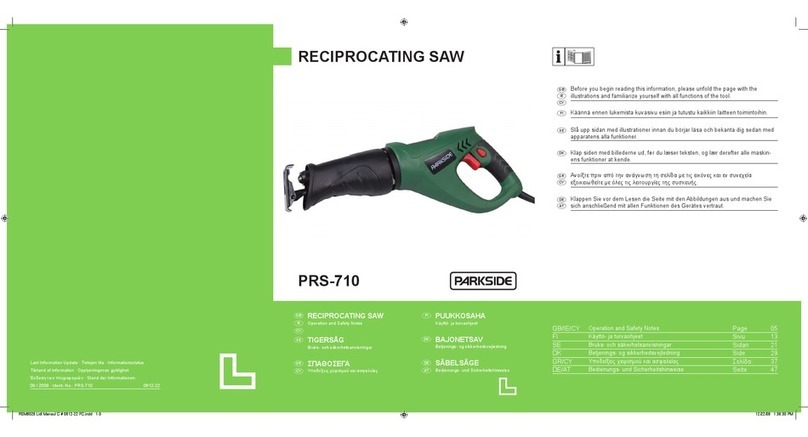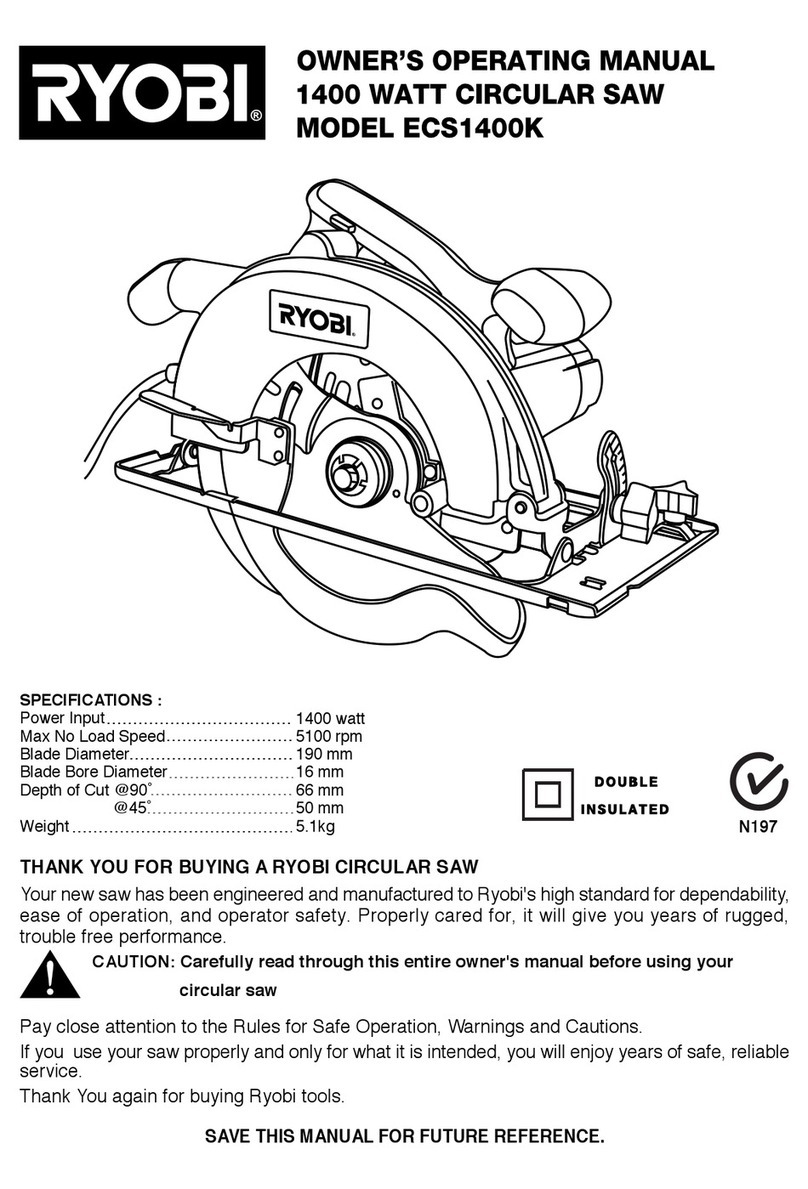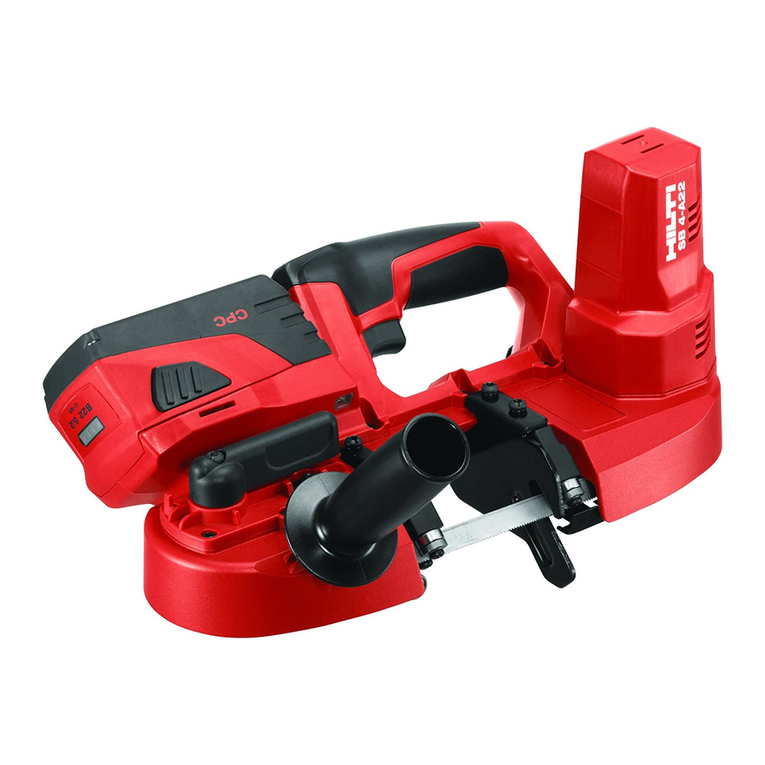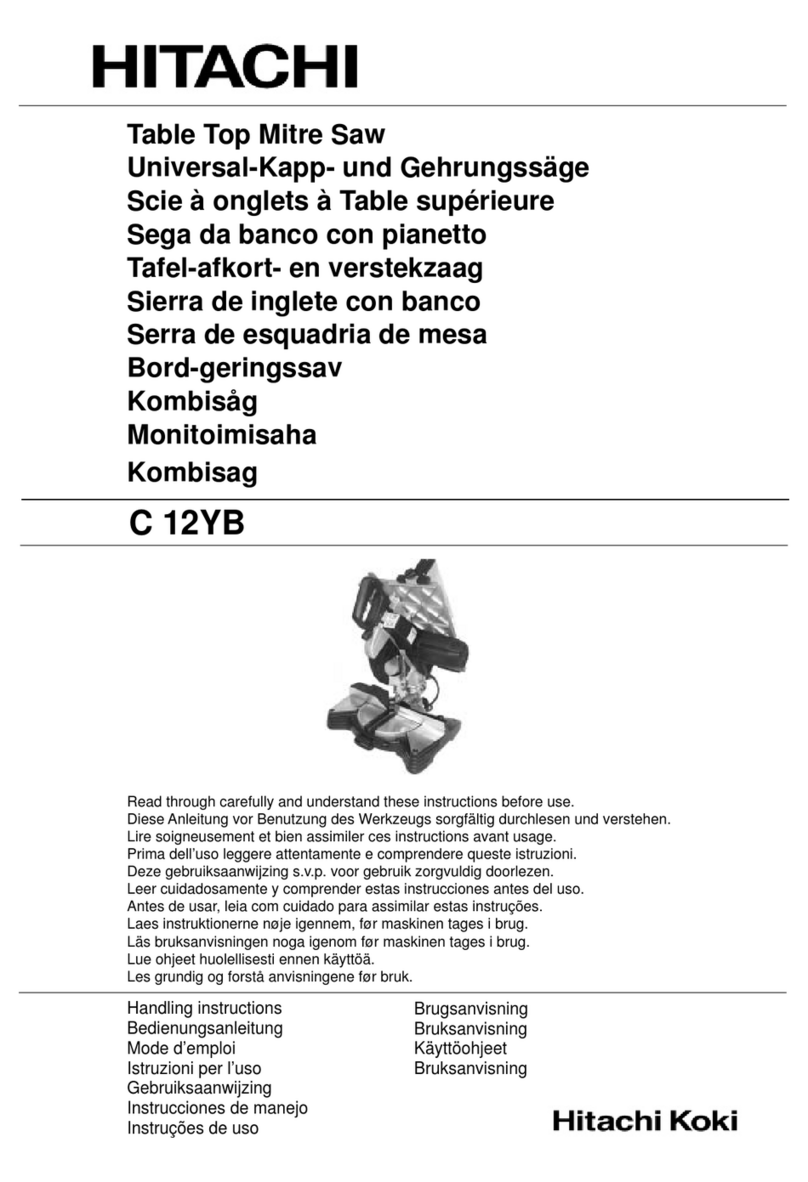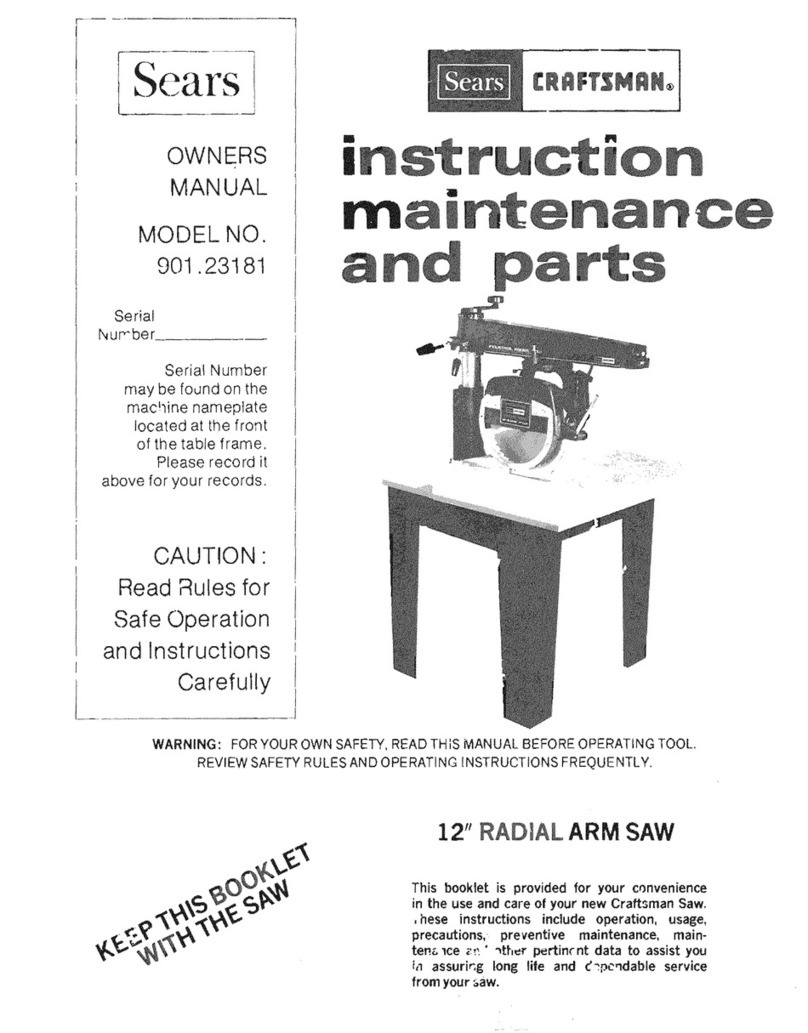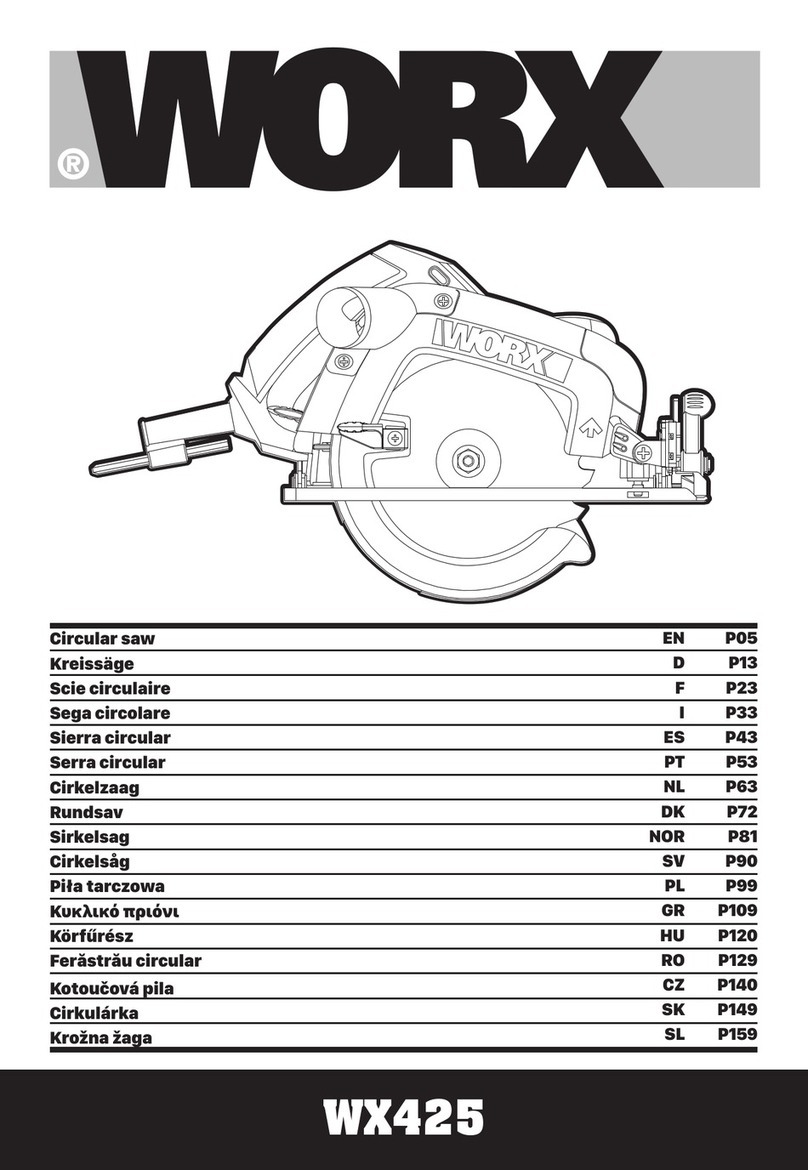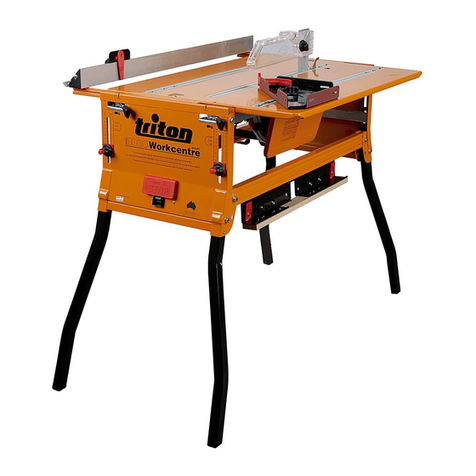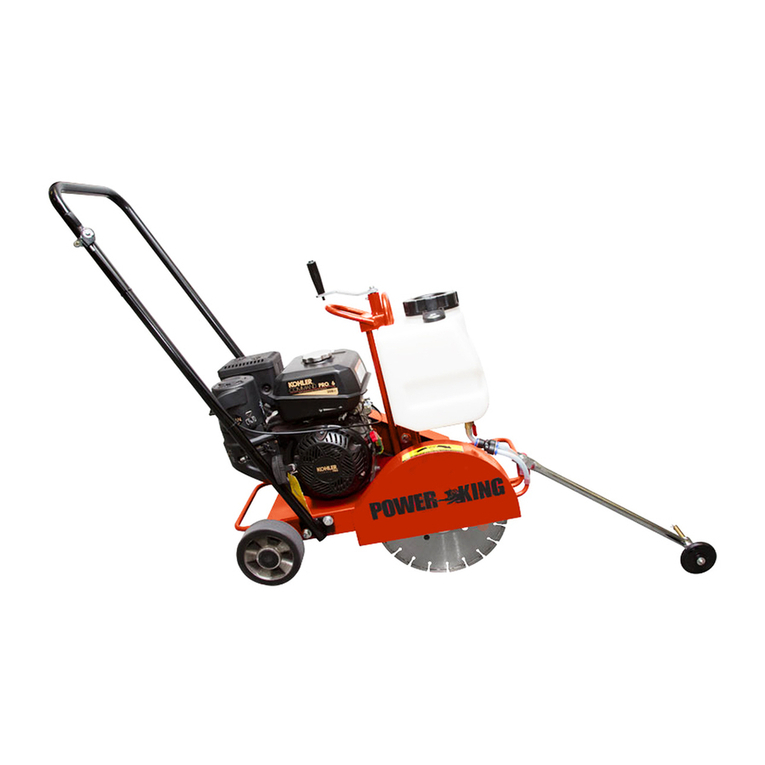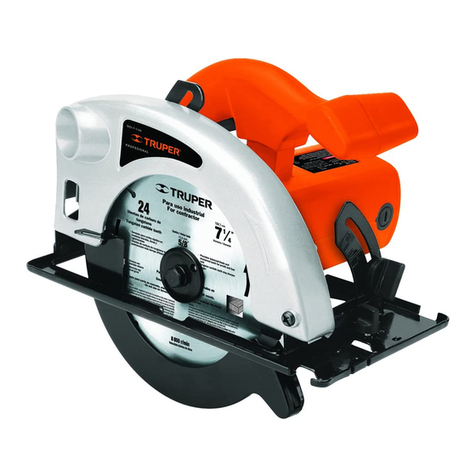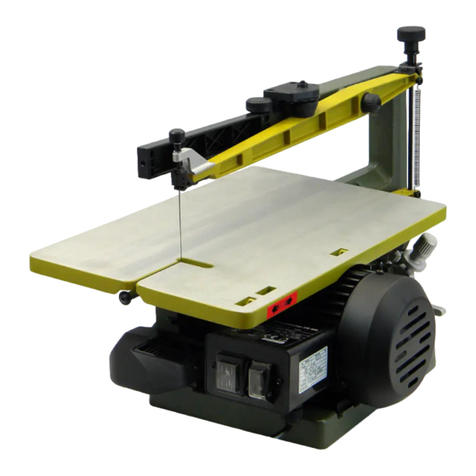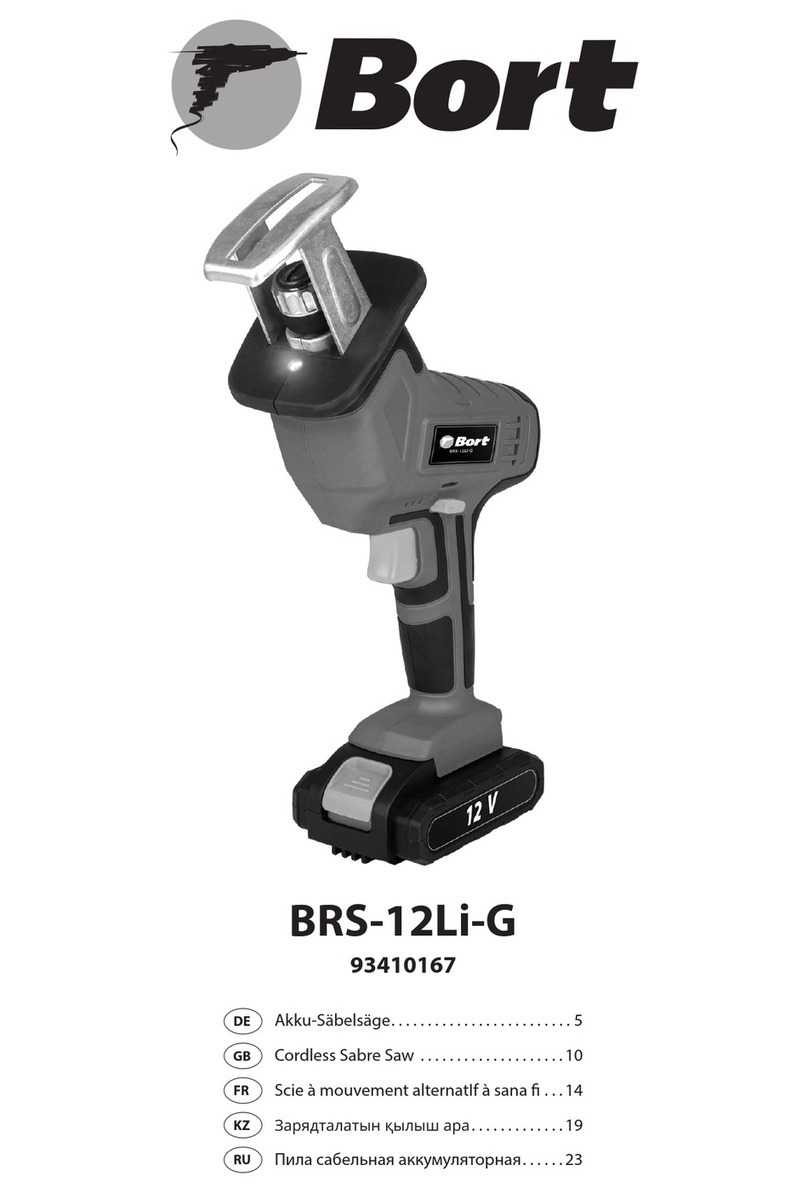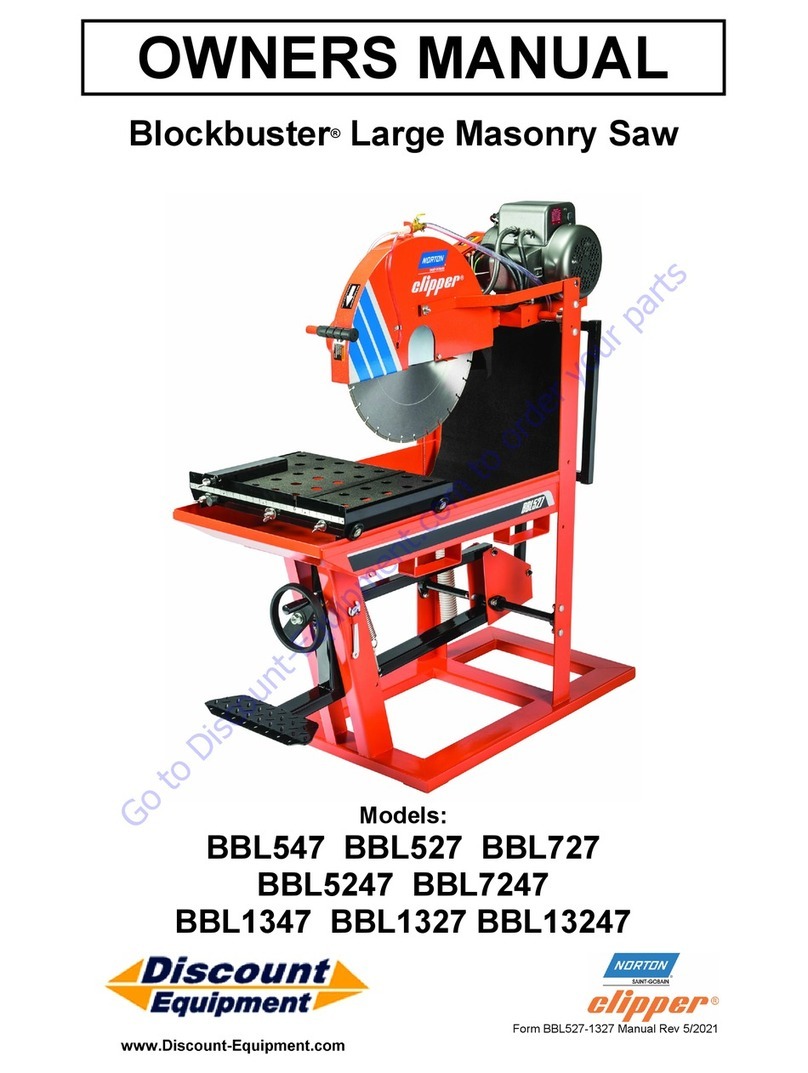GÖLZ Bridge Saw Installation instructions

1 / 86
Translation of the Original Operating
Manual
Bridge Saw –GS 350A-120
Read operating manual before starting any work!
Keep the operating manual for future use!

2 / 86

1 Content
3 / 86
Revision
Date
Chapter
Reason of change
Person responsible
03-19
Recreation
Design
02-21
12.4.2
Wheel set changed
Design
Revision status: 2021-02
Serial number:
© Gölz GmbH
Dommersbach 51
D- 53940 Hellenthal
Tel.: +49 (0)2482 –12 200
Fax: +49 (0)2482 –12 222
Internet: www.goelz.de

1 Content
4 / 86
1 Content
1Content .........................................................................................................................................................4
2General information ....................................................................................................................................7
2.1 Operating manual .............................................................................................................................7
2.2 Symbols, abbreviations, terms..........................................................................................................7
2.3 Explanation of symbols.....................................................................................................................7
2.4 Limitation of liability...........................................................................................................................8
2.5 Customer Service .............................................................................................................................9
2.6 Copyright...........................................................................................................................................9
3Safety..........................................................................................................................................................10
3.1 Appropriate use ..............................................................................................................................10
3.2 Reasonably foreseeable misuse ....................................................................................................10
3.3 Responsibility of the operator.........................................................................................................11
3.4 Responsibility of the staff................................................................................................................12
3.5 Personnel requirements..................................................................................................................12
3.6 Personal protective equipment.......................................................................................................13
3.7 Dangers ..........................................................................................................................................13
3.7.1. Risks from mechanical hazards.........................................................................................13
3.7.2 Risks from electrical hazards.............................................................................................14
3.7.3 Risks from thermal hazards...............................................................................................14
3.7.4 Risks due to specific physical agents ................................................................................15
3.7.5 Risks from hazardous substances.....................................................................................15
3.7.6 Risks from working environment conditions ......................................................................15
3.7.7 Risks due radiation hazards ..............................................................................................15
3.8 Safety devices ................................................................................................................................15
3.9 Spare parts .....................................................................................................................................16
3.10 Conduct in case of danger and accidents ......................................................................................16
3.11 Signage...........................................................................................................................................17
4Technical data............................................................................................................................................19
4.1 Dimension machine........................................................................................................................19
4.2 Dimensions of cut material .............................................................................................................19
4.3 Connection and motor values.........................................................................................................19
4.4 Other data.......................................................................................................................................19
4.5 Water pump....................................................................................................................................19
4.6 Laser...............................................................................................................................................19
4.7 Noise emissions..............................................................................................................................19
4.8 Operating conditions.......................................................................................................................20
4.9 Cutting blades.................................................................................................................................20
4.10 Type plate.......................................................................................................................................21
4.11 Requirements for the installation site .............................................................................................21
4.12 Storage requirements.....................................................................................................................21
5Design and function..................................................................................................................................22
5.1 Scope of delivery and responsibilities ............................................................................................22
5.2 GS 350A-120..................................................................................................................................23
5.2.1 Functional description........................................................................................................24
6Transport & Packaging ............................................................................................................................25
6.1 Safety instructions for transport......................................................................................................25
6.2 Transport Inspection.......................................................................................................................25
6.3 Transport symbols ..........................................................................................................................25
6.4 Transportation and storage.............................................................................................................26
7Installation and initial commissioning ....................................................................................................28
7.1 Safety Instructions for Installation...................................................................................................28
7.2 Setting up........................................................................................................................................28

1 Content
5 / 86
7.3 Connect...........................................................................................................................................29
7.4 Initial commissioning and acceptance, general..............................................................................29
7.4.1 Measures before initial commissioning..............................................................................30
7.4.1.1 Mounting the cut-off wheel.......................................................................................30
7.4.1.2 Filling the water sump..............................................................................................30
8Operating....................................................................................................................................................32
8.1 Safety instructions for operation.....................................................................................................32
8.2 Intended working position of the operator ......................................................................................32
8.3 Preparations for launch...................................................................................................................33
8.4 Switch on ........................................................................................................................................33
8.5 Cutting process...............................................................................................................................34
8.5.2 45°- bevel cuts...................................................................................................................35
8.5.3 Water supply......................................................................................................................36
8.6 Ending the cutting process .............................................................................................................36
9Maintenance & Cleaning...........................................................................................................................37
9.1 Safety instructions for maintenance ...............................................................................................37
9.2 Maintenance plan ...........................................................................................................................37
9.3 Description of the maintenance work carried out by the operator..................................................39
9.3.1 Changing the blade............................................................................................................39
9.3.2 Check the water connection ..............................................................................................39
9.3.3 Water pump and water sump.............................................................................................39
9.4 Measures after maintenance..........................................................................................................39
9.5 Note on components subject to wear and tear...............................................................................40
10 Faults ..........................................................................................................................................................41
10.1 Safety Instructions for Troubleshooting..........................................................................................41
10.2 Behaviour in case of disturbances..................................................................................................41
10.3 Fault table.......................................................................................................................................42
10.4 Measures to be taken after the fault has been rectified .................................................................44
11 Disassembly and disposal........................................................................................................................45
11.1 Safety instructions for disassembly and disposal...........................................................................45
11.2 Disassembly....................................................................................................................................45
11.3 Disposal..........................................................................................................................................45
12 Spare parts list...........................................................................................................................................47
12.1 Use of the spare parts list...............................................................................................................47
12.2 Sales offices....................................................................................................................................47
12.3 Exploded views and spare parts lists .............................................................................................49
12.3.1 Machine .............................................................................................................................49
12.3.2 Support leg cpl...................................................................................................................50
12.3.3 Frame cpl...........................................................................................................................51
12.3.4 Water sump cpl..................................................................................................................55
12.3.5 Guide bridge cpl.................................................................................................................57
12.3.6 Cut material table steel-version cpl....................................................................................61
12.3.7 Cut material table aluminium-version cpl...........................................................................62
12.3.8 Cutting head mounting cpl.................................................................................................63
12.3.9 Cutting head cpl.................................................................................................................65
12.3.10 Protection cover cpl. ..........................................................................................................67
12.3.11 Transport wheel cpl............................................................................................................71
12.3.12 Tool holder with tool...........................................................................................................72
12.3.13 Long handle .......................................................................................................................73
12.3.14 Stop bracket cpl.................................................................................................................74
12.3.15 Transport handle cpl..........................................................................................................75
12.3.16 Laser..................................................................................................................................76
12.3.17 Guide spindle.....................................................................................................................77
12.3.18 Eccentric spindle................................................................................................................78
12.3.19 Cutting head handle...........................................................................................................79

1 Content
6 / 86
12.4 Optional accessories ......................................................................................................................80
12.4.1 Roll jib ................................................................................................................................80
12.4.2 Transport wheelset Support leg.........................................................................................81
12.4.3 Lateral jib ...........................................................................................................................82
12.4.4 T-Lock tile clamping device ...............................................................................................83
12.4.5 Tile stop .............................................................................................................................84
13 Wiring diagram...........................................................................................................................................85
EU conformity declaration.............................................................................................................................86

2 General information
7 / 86
2 General information
2.1 Operating manual
These operating instructions provide all the information required for safe and efficient handling of
the machine and form the basis for all actions performed on it. It is an integral part of the machine
and must be kept in its immediate vicinity and accessible at all times to the personnel working on
it.
A prerequisite for safe working on the machine is that all specified safety instructions and
instructions for action are observed. The personnel must therefore have carefully read and
understood this operating manual before starting any work.
In addition, the local accident prevention regulations and general safety regulations applicable at
the place of use of the machine must be observed
2.2 Symbols, abbreviations, terms
This document uses signs, abbreviations and technical terms with the following meaning:
See under
- Enumeration
1 Position number
1. Action step
Text in italics Comments on facts
Refers to a document contained in the documentation supplied. The place where
the document was found is indicated in italics after the symbol.
2.3 Explanation of symbols
Warnings and safety instructions
Warnings and safety instructions in the manual are marked by pictograms and highlighted in a grey
highlighted block.
Warning and safety instructions that draw attention to fundamental dangers are additionally
introduced with signal words that express the extent of damage. These are structured as follows:
Observe all warnings and safety instructions!
Always act with caution when working to avoid accidents, personal injury and damage to
property!
The pictograms in connection with the signal words mean
SIGNAL WORD!
Origin of the danger!
Consequences if the danger is not observed.
- Code of conduct to avoid the danger
DANGER!
... indicates an imminent danger that will result in death or serious injury if not avoided.
WARNING!
… indicates a potentially hazardous situation which, if not avoided, could result in death or
serious injury.

2 General information
8 / 86
Tips and recommendations
Special safety instructions
To point out special dangers, the following pictograms are used in conjunction with safety
instructions:
2.4 Limitation of liability
All information and notes in these instructions have been compiled taking into account applicable
standards and regulations, the state of the art and our many years of knowledge and experience.
The manufacturer assumes no liability for damages due to:
Non-compliance with the instructions
Unintended use
Use of untrained and uninformed personnel
Arbitrary conversions
Technical changes
Use of non-approved spare parts
NOTE!
… highlights tips, recommendations and information for efficient and trouble-free operation.
... indicates hazards due to electric current.
Non-observance of the safety instructions may result in serious or fatal injuries.
... indicates danger of crushing.
If the safety instructions are not observed, there is a risk of serious injury on moving parts.
...indicates hazards from hot surfaces.
If the safety instructions are not observed, there is a risk of burns and serious skin injuries due to
heat.
... indicates hazards due to rotating cut-off wheels.
If the safety instructions are not observed, there is a risk of cuts and serious skin injuries from
rotating cutting discs.
CAUTION!
… indicates a potentially hazardous situation which, if not avoided, may result in minor injuries.
ATTENTION!
… indicates a potentially hazardous situation which may result in damage to property if not
avoided.

2 General information
9 / 86
The obligations agreed in the supply contract, the General Terms and Conditions of Business as well as
the manufacturer's terms of delivery and the legal regulations valid at the time of conclusion of the
contract shall apply.
Warranty
The manufacturer guarantees the functionality of the applied process technology and the stated
performance parameters.
The warranty period begins with the defect-free handover.
Wearing parts
Wearing parts are all components that are in direct contact with the material to be treated or
processed during proper operation. These components are excluded from warranty and defect
claims, as far as they are operational wear and tear.
Service life guarantee
A service life guarantee is given for wear parts for a period of 6 months after acceptance without
defects.
Warranty conditions
12 months after delivery on mechanical and electrical components for single-shift operation,
excluding wear parts and tools.
The warranty claim expires if the system is not installed and started up by our specialists.
The warranty extends to the parts to be replaced. Consequential damages are excluded.
Also excluded are damages caused by natural wear and tear, defective or improper maintenance,
disregard of operating instructions, excessive strain and use of unsuitable equipment.
2.5 Customer Service
Our customer service is available for technical information.
Information about the regionally responsible contact person can be obtained by telephone and is
available at any time by fax, e-mail or via the Internet.
In addition, our employees are always interested in new information and experience that results from
the application and can be valuable for the improvement of our products.
2.6 Copyright
This document is protected by copyright. Unauthorized transfer of the manual to third parties,
duplication in any form or manner, even in part, as well as the use and/or communication of the
contents are not permitted without the written permission of the publisher.
Contraventions obligate to compensation for damages. Further claims are reserved.
Service-Hotline
02482 –12 200

3 Safety
10 / 86
3 Safety
This section provides an overview of all safety aspects for the protection of the operator and user
from possible dangers and the safe and trouble-free operation of the system.
Non-observance of the listed instructions, warnings and safety instructions can result in considerable
dangers.
3.1 Appropriate use
The bridge saw GS350A-120 is intended exclusively for the following commercial use:
Claims of any kind for damage resulting from improper use are excluded.
The operator alone is liable for all damage caused by improper use.
3.2 Reasonably foreseeable misuse
Any use of the machine beyond its intended use is considered improper and is prohibited.
This applies in particular to:
the separation of non-approved building materials, e.g. wood, metal, plastic
the separation of any materials other than those listed
cutting without or with opened cut-off wheel protective cover
cutting without water
cutting of the material to be cut using the pendulum cutting method (vertical immersion from
above into the material to be cut)
The Bridgesaw GS350A-120
is designed for wet cutting of solid building materials, such as
clinker, bricks, concrete products, refractory, natural and artificial stone products, tiles
and ceramics.
WARNING!
Danger due to improper use!
Any use of the machine other than the intended use can lead to dangerous situations.
- Only use the machine for its intended purpose in accordance with the information in this
document, in particular in compliance with the application limits specified in the technical data.
- Do not use the machine for any other purpose or in any other way.
- Do not modify, convert or change the design or individual parts of the equipment with the aim of
changing the area of application or the usability of the machine.
Translated with www.DeepL.com/Translator (free version)
WARNING!
Risk of injury through misuse!
Misuse of the machine can lead to dangerous situations for persons and cause serious damage
to property.
- Do not misuse the machine.

3 Safety
11 / 86
3.3 Responsibility of the operator
Operator
The operator is any natural or legal person who uses the machine or allows third parties to use it
and is responsible for the safety of the user, personnel or third parties during use.
Obligations of the operator
The machine is used in the commercial sector. The operator of the machine is therefore subject to
the legal obligations for occupational safety.
In addition to the warning and safety instructions in this manual, the safety, accident prevention and
environmental protection regulations valid for the area of application of the machine must be
observed.
In particular, the operator must:
inform themselves about the applicable occupational health and safety regulations.
identify possible additional hazards through a risk assessment, which are
special application conditions at the place of use of the machine.
operating instructions implement the necessary behaviour requirements for the operation of the
machine at the place of use.
regularly check during the entire period of use of the machine whether the operating instructions
issued by him correspond to the current status of the regulations.
adapt the operating instructions, if necessary, to new regulations, standards and operating
conditions
clearly and unambiguously define the responsibilities for the installation, operation, maintenance
and cleaning of the machine
Ensure that all employees working on the machine have read and understood the operating
instructions. In addition, he must train the personnel at regular intervals in the use of the
machine and inform them about the possible dangers.
provide the personnel responsible for working on the machine with the prescribed and
recommended protective equipment
Furthermore, the operator is responsible for ensuring that the machine
is always in a technically perfect condition.
is maintained in accordance with the specified maintenance intervals.
all safety devices of the machine are regularly checked for completeness and functionality.

3 Safety
12 / 86
3.4 Responsibility of the staff
The machine is in commercial use. The personnel is therefore subject to the legal obligations for
occupational safety.
In addition to the warning and safety instructions in this manual, the safety, accident prevention and
environmental protection regulations valid for the area of application must be observed.
In particular, the personnel:
is informed about the applicable occupational health and safety regulations.
complies with the behaviour requirements laid down in the operating instructions for the operation
of the machine on site.
properly carries out the assigned responsibilities for the operation, maintenance and cleaning of
the machine
must have read and understood the operating instructions completely before starting work.
uses the prescribed and recommended protective equipment
Furthermore, each employee working on the machine is responsible, within his scope of
responsibility, for ensuring that the machine
is always in technically perfect condition.
is maintained according to specified maintenance intervals.
all safety devices are regularly checked for completeness and functionality.
3.5 Personnel requirements
Basic information
Any work on the machine may only be carried out by persons who are able to carry out their work
properly and reliably and who comply with the respective specified requirements.
Persons whose reactions are affected, e.g. by drugs, alcohol or medication, must not carry out
any work.
When employing personnel, always observe the age and occupation-specific regulations
applicable at the place of use.
Qualification
Instructed personnel
Instructed personnel are persons who have been informed in detail and verifiably by the operator
about the tasks assigned to them and possible dangers.
Technical staff
Qualified personnel are deemed to be those who, on the basis of their professional training,
knowledge and experience as well as knowledge of the relevant regulations, are able to carry out
the assigned work properly, recognise possible dangers independently and avoid personal injury or
damage to property.
Qualified electrical personnel
All work on the electrical equipment may only be carried out by qualified electricians.
Qualified electricians are persons who, due to their technical training, knowledge and experience as well as their
knowledge of the relevant regulations, are able to carry out work on electrical equipment properly, to recognize
possible dangers independently and to avoid personal injury and damage to property caused by electric current.
WARNING!
Risk of injury due to insufficient qualification!
Improper work can lead to considerable personal injury and damage to property.
- All activities may only be performed by persons who have the necessary training,
knowledge and experience.

3 Safety
13 / 86
Unauthorized persons
3.6 Personal protective equipment
Personal protective equipment must be worn during work.
3.7 Dangers
The machine has been subjected to a risk assessment. The hazards identified in this assessment
have been eliminated as far as possible and any risks identified have been reduced.
Nevertheless, the machine still poses residual risks, which are described in the following section.
The warning and safety instructions given here and in the chapters of this manual must be strictly
observed to avoid possible damage to health and dangerous situations.
3.7.1. Risks from mechanical hazards
Rotating tools
WARNING!
Risk of injury to unauthorised persons!
Non-instructed persons are not aware of the dangers in the work area and are considered to be
unauthorized.
- Keep unauthorised persons away from the work area, in case of doubt contact the
persons concerned and show them to leave the work area.
- Interrupt work while unauthorized persons are in the work area.
-
(1) Helmet with hearing protection
(2) Visor or safety goggles
(3) Dust protection / breathing mask
(4) Safety gloves
(5) Suitable protective clothing
(6) Safety shoes with protective cap
NOTE!
Protective gloves must not be worn for rotating parts where there is a risk of being drawn in. Here
the risk of wearing is clearly higher than the intended protective effect.
CAUTION!
Risk of injury through cuts!
Reaching into rotating tools can lead to serious injuries.
- Never touch the rotating blade
- Never work without blade protection
- Only work with closed blade protective cover
- Remove cut material only when the cutting wheel is stationary

3 Safety
14 / 86
Flying cut material / tool
Movable components
3.7.2 Risks from electrical hazards
Electric current
3.7.3 Risks from thermal hazards
Hot surfaces
CAUTION!
Risk of burns from hot surfaces!
Contact with hot components can cause burns.
- Do not touch surface
- Before all work, ensure that the components have cooled down to ambient temperature.
CAUTION!
Risk of injury from pieces of cut material or tools flying around!
Failure to wear suitable protective equipment, working with the cut-off wheel protective cover
open or with unsuitable cut-off wheels can lead to serious injury.
- Wear protective goggles
- Only work with closed protective cover
- Only work with blades that are designed for the material to be cut
CAUTION!
Risk of injury from crushing moving parts!
Failure to wear suitable protective equipment can lead to serious injury.
- Wear protective gloves
- Lock the cutting head
- Lock the guide bridge
DANGER!
Danger to life from electric current!
Touching live parts leads to death. Damage to the insulation or individual components can be life-
threatening.
- Before starting any work on the electrical system, disconnect the machine from the power
supply. Check that the machine is de-energised!
- Before maintenance, cleaning and repair work, switch off the electrical power supply and
secure it against being switched on again.
- If the insulation is damaged, switch off the power supply immediately and arrange for
repair.
- Do not bypass or disable fuses.
- When replacing defective fuses, always ensure that the current rating is correct.
- Keep moisture and humidity away from live parts.
- Any work on the electrical system may only be carried out by qualified electricians.

3 Safety
15 / 86
3.7.4 Risks due to specific physical agents
3.7.5 Risks from hazardous substances
3.7.6 Risks from working environment conditions
3.7.7 Risks due radiation hazards
3.8 Safety devices
WARNING!
Danger to life due to defective or bypassed safety devices!
Safety devices that are not functioning, bypassed or disabled do not protect against the dangers
and can lead to serious injury or death.
- Always check that all safety devices are correctly installed and functional before starting
work.
- Never override safety devices.
- Ensure that the safety devices are always freely accessible
NOTE!
Location of the safety devices "Design and function".
CAUTION!
Risk of injury due to special physical effects!
Failure to wear suitable protective equipment can lead to serious injury.
- Wear ear protection
- Wear safety gloves
- Observe appropriate breaks
- Regular medical check 'G20 ‘
CAUTION!
Risk of injury from hazardous substances such as dust and cutting water or cutting
sludge!
Failure to wear suitable protective equipment may result in damage to health.
- Use personal protective equipment
- Replace cutting water regularly
- Use a dust mask
- Switch on water supply
CAUTION!
Risk of injury due to insufficient lighting.
Working under inadequate lighting can lead to serious injury.
- Ensure adequate lighting at the workplace
CAUTION!
Risk of injury due to inadequate lighting.
Work in inadequate lighting conditions may lead to heavy injuries.
- Provide for adequate lighting at the workplace.

3 Safety
16 / 86
Emergency stop switch
By pressing the emergency stop switch, the drive of the machine is switched off. The power supply
up to the switch is maintained. Disconnect the machine from the power supply by pulling the mains
plug. Eliminate the fault that has occurred before switching on again after an emergency stop.
3.9 Spare parts
Original spare parts can be obtained from authorised dealers or directly from the manufacturer.
3.10 Conduct in case of danger and accidents
Preventive measures
Always be prepared for accidents and fire.
Keep first aid equipment (first aid kit, blankets, etc.) and fire extinguishers handy.
Familiarise personnel with the accident reporting, first aid and rescue facilities.
Always keep access routes for rescue vehicles clear.
Acting correctly in the event of an emergency
Trigger emergency stop immediately
initiate first aid measures
Rescue affected persons from the danger zone.
Inform the person responsible at the place of operation.
In case of serious injury, alert the doctor and/or fire brigade.
Keep access routes open for escape routes.
WARNING!
Risk of injury due to incorrect spare parts!
Faulty spare parts can seriously impair safety and cause damage, malfunctions or even total
failure.
- Only use original spare parts.
Emergency stop switch

3 Safety
17 / 86
3.11 Signage
Danger from electric current
Danger from cuts
CAUTION!
Risk of injury through cuts!
Reaching into moving tools can lead to serious injuries.
- Never touch the rotating blade
- When changing the blade disconnect the machine from the power supply
DANGER!
Danger to life from electric current!
Touching live parts leads to death. Damage to the insulation or individual components can be
life-threatening.
- Before starting any work on the electrical system, disconnect the machine from the
power supply. Check that the machine is voltage-free!
- Before maintenance, cleaning and repair work, switch off the electrical power supply and
secure it against being switched on again.
- If the insulation is damaged, switch off the power supply immediately and arrange for
repair.
- Do not bypass or disable fuses.
- When replacing defective fuses, always ensure that the current rating is correct.
- Keep moisture and humidity away from live parts.
- Any work on the electrical system may only be carried out by qualified electricians.
- annual inspection of the electrical system according to VDE0701

3 Safety
18 / 86
Illegible signage
The following symbols and information signs are located on the machine to draw attention to possible
dangers:
Warning of rotating tool!
Direction of rotation of the saw
blade
wear gloves
wear hearing protection
Machine complies with EU
directive
Observe operating instructions
Wear protective goggles
Laser class:II
wavelength, type: 635nm
Look out!
Do not look into the beam
CAUTION!
Risk of injury due to illegible symbols!
Stickers and signs that have become obscure no longer make danger spots sufficiently
recognizable and cannot indicate possible injury hazards.
- Always keep pictograms, safety, warning and operating instructions in a clearly legible
condition.
- Replace damaged or illegible pictograms, inscriptions, signs or stickers immediately.

4 Technical data
19 / 86
4 Technical data
4.1 Dimension machine
4.3 Connection and motor values
Information
Value
Unit
Information
Value
Unit
Nominal voltage
230
V
Water sump
30
l
Nominal frequency
50
Hz
Cutting blade
350
mm
Power
2,2
kW
Bore
25,4
mm
Power consumption
13
A
Flange Ø
90
mm
Necessary protection
16
A
Vibration value
2,3
m/s2
Cutting shaft speed
2800
U/min
Motor protection class
IP55
Measuring tolerance
Motor operating mode
S6
Vibration value
0,2
m/sec^2
4.5 Water pump
Information
Value
Unit
Information
Value
Unit
Nominal voltage
230
V
Power
1
mW
Nominal frequency
50
Hz
Rated current, max.
50
mA
Power
55
W
Nominal voltage
3-6
V DC
Operating mode
S2
Wavelength
635
nm
Pulse duration
stufenlos
Class
II
Protection class
III
4.7 Noise emissions
Without
load
Full load
Measuring tolerances
Sound pressure level
64 dB (A)
78 dB (A)
Sound pressure level
4 dB (A)
Sound power level
75 dB (A)
91 dB (A)
Sound power level
2,5 dB (A)
Guaranteed sound
power level
80 dB (A)
The specification defines the volume of the noise pollution, in relation to the operator's workplace and the
sound power level of the machine.
The emission values were carried out in accordance with the standards EN ISO 3744, EN 12418 and
Directive 2005/88/EC.
Information
Value
Unit
Information
Value
Unit
Length
1500
mm
max. Length
1250
mm
Width
640
mm
max. Width
600
mm
Height
1490
mm
Max. Height
100
mm
Tare weight
113
kg
max. Weight
80
kg
Operating Weight
145
kg
4.2 Dimensions of cut material
4.4 Other data
4.6 Laser

4 Technical data
20 / 86
4.8 Operating conditions
Workspace
Angabe
Value
Unit
Temperature range
Room temperature 5-45
°C
Relative humidity, maximum
60
(without condensation)
%
Conditions
Only operate the machine in a dust-free environment!
Avoid direct wetness, dust exposure and frost.
Do not operate in strong electric and magnetic fields!
Do not operate the machine in an explosive environment!
4.9 Cutting blades
Cutting blade
Cutting blade
diameter
Material
Number of
segments
Segment
height
SlimFast
Ø 350 mm
ceramic, fine stoneware,
tiles, marble, granite
-
10 mm
RX1
concrete, exposed
aggregate concrete, brick,
clinker, hard stone, granite
24
16 mm
GN25
hard stone, granite, natural
and artificial stone
24
10 mm
NOTE!
All cut-off wheels used must be designed for the maximum drive speed of the machine and the
intended use with regard to their permissible maximum cutting speed.
DANGER!
Risk of injury due to defective or incorrectly mounted blades!
Wrong direction of rotation and damaged cut-off wheels can lead to serious personal injury!
- Before starting work, check cut-off wheels for breakage of individual segments, segment
pieces, cracks at the segment foot, deformation of the cut-off wheel or wear.
- Observe direction of rotation arrows on the cut-off wheel and cut-off wheel protective
cover!
DANGER!
Risk of injury from untested or approved tools!
Untested or approved cutting discs or circular saw blades can cause serious personal injury!
- Check that the correct cut-off wheel is fitted before starting work.
- Observe direction of rotation arrows on the cut-off wheel and cut-off wheel protective
cover!
This manual suits for next models
1
Table of contents
Other GÖLZ Saw manuals
